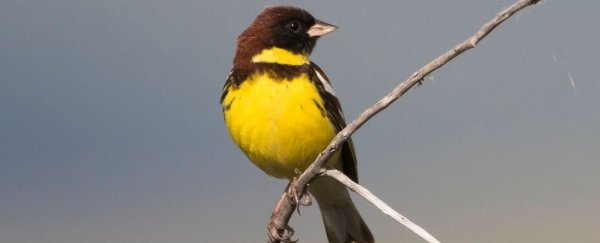Thousands of wild bird species are growing ill or dying from habitat loss, climate change, and overexploitation, according to new research.
A new estimate from researchers around the world has found 48 percent of living bird species are known or suspected to have declining populations.
That's more than 5,000 species that face a risky future. Among the species surveyed, only 6 percent showed increases in population.
"We are now witnessing the first signs of a new wave of extinctions of continentally distributed bird species," says conservation biologist Alexander Lees from Manchester Metropolitan University in the UK, and also at the Cornell Lab of Ornithology.
"Avian diversity peaks globally in the tropics and it is there that we also find the highest number of threatened species."
The appalling results come from some of the same team who, in 2019, calculated nearly 3 billion breeding birds had been lost in Northern America since the 1970s.
In 2021, another study determined that millions of birds had vanished in Europe in the past 40 years.
The recent estimates suggest similar patterns exist right across the planet, but especially in tropical, polar, and montane birds.
Without transformative action, thousands of avian species around the world are at risk of endangerment or even extinction.
Compared to temperate regions, there isn't a lot of long-term data on bird population trends in tropical and subtropical latitudes. But in some nations, like South Africa, evidence indicates at least half of all birds that depend on the forest are losing habitat.
In all likelihood, that loss is impacting bird abundance, but no research has shown exactly how much.
In Costa Rica, which is famed for bird biodiversity, avian abundance has declined over the past decade.
A review of the literature suggests most hotspots for threatened bird species exist in the tropical Andes, southeast Brazil, the eastern Himalayas, eastern Madagascar, and Southeast Asian islands.
"Estimates based on current trends predict an overall effective extinction rate… six times higher than the rate of outright extinction since 1500," the authors of the review write.
In temperate zones, like some spots of Australia, the struggle is particularly severe for farmland and woodland bird species, largely due to habitat loss.
In Japan, there's a similar trend occurring among the brown shrike and the yellow-breasted bunting, which have lost huge parts of their range.
Wetland birds in temperate zones seem to be holding up better, largely due to restoration efforts in North America and Europe.
The finding is reason not to give up, the researchers say. If we can limit selective logging, control wildfires and overgrazing, and improve habitat quality, we have the power to maintain and even restore wild landscapes.
"The fate of bird populations is strongly dependent on stopping the loss and degradation of habitats," says Lees.
"That is often driven by demand for resources. We need to better consider how commodity flows can contribute to biodiversity loss and try to reduce the human footprint on the natural world."
Climate change is also threatening birds, forcing population ranges to expand or shrink. Birds that live on mountaintops are particularly vulnerable to rising temperatures, as they tend to have nowhere else to flee. Some scientists have called this problem 'an escalator to extinction'.
Migrating birds could also be impacted by climate change. With changing temperatures and shifting seasons, some studies suggest that birds are arriving or leaving their destinations too early or too late to survive as per usual.
Birds are some of the most well-studied animals on our planet, so how they are faring in a rapidly changing world has important implications for our understanding of wildlife as a whole.
Birds are not only pollinators and key players in ecosystems, they are sensitive indicators of environmental health.
That's why canaries were traditionally used to detect toxic gasses in mines: what harms them will also impact us, too, in time, as our fates are intrinsically linked.
"Fortunately, the global network of bird conservation organizations taking part in this study have the tools to prevent further loss of bird species and abundance," says retired conservation scientist Ken Rosenberg, who once worked at Cornell.
"From land protection to policies supporting sustainable resource-use, it all depends on the will of governments and of society to live side by side with nature on our shared planet."
The study was published in the Annual Review of Environment and Resources.
